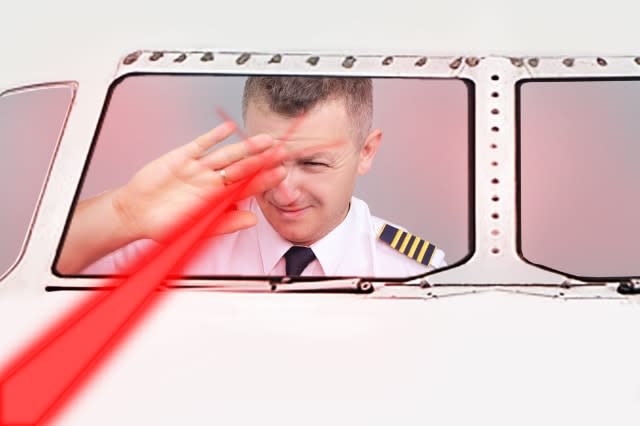Laser attacks mid-air 'an unnerving experience', says pilot

A pilot who has been targeted at least 20 times with a laser has said it is "quite an unnerving" thing to happen while in the air.
Ollie Dismore, director of operations for the National Police Air Service, who has been a pilot for more than three decades, said there were 108 reports of lasers being used against force helicopters last year alone.
See also: Flight forced to turn back after laser attack injures co-pilot
Calling the issue of laser attacks a "growing problem", especially with the powerful lasers that are now available, he said "you will not find a police pilot who has not been targeted multiple times".
In a 23-year career as a police helicopter pilot, Mr Dismore said he has been targeted by a laser "many times" - estimating the figure to be well in excess of 20.
He described being targeted with a laser while flying an aircraft as similar to walking through the beam of a high powered LCD presentation projector.
"When this comes upon you in the dark it will come through one side into the canopy, which is a bit like a goldfish bowl, and bounces around the internal surfaces - you get a very distracting flickering effect of the beam inside the cockpit," he said.
"It is quite disorientating because it is not a steady light that you can look at and your eyes adjust to, it is a flickering strobing effect. And if you are trying to fly the aircraft and look at the instruments then it is quite an unnerving experience."
Police helicopter pilots are trained to safely turn away from the beam and the force have trialled laser eye wear protection.

Effects of a laser being directed at the eyes can include flash blindness, after-image and glare, and in rare cases - such as with a BA pilot last year - significant damage to the retina.
"It is made worse at night - your pupils are wide because light levels are low - so you can get quite a significant after image while you wait for it to clear. In extreme cases it is like having dust in your eye, and it will stream," said Mr Dismore.
He said alongside police aircraft, commercial airliners and military jets, lasers are also being used against drivers from motorway bridges, as well as police on the streets and at demonstrations, and train drivers.
With 100 pilots across the country spread over 17 bases, Mr Dismore said the force have a high rate of catching individuals because of the on-board technology.
He said: "As soon as we get any bright light or a laser on our camera it links directly to a mapping system and gives us a pinpoint location of where the perpetrator is and their image is caught and recorded.
"And if we can get ground units to them quickly we actually have quite a good success rate in terms of seizing the laser, and - depending on the severity of the attack - progressing it through the criminal justice system."
He added: "There have been some six-month custodial sentences handed out."
And it is this technology that is helping them work with the UK's largest airports to tackle the problem of laser attacks - with the helicopters deployed to locations such as Stansted, Gatwick and Manchester.
"We have been asked in the past to go and become a target so that we can get those doing it on camera. We put the helicopter into the traffic pattern with the airliners coming in, and peel off when it is struck and find the perpetrators on the ground," he said.
Mr Dismore said people need to understand the consequences of their actions when they guide a laser towards an aircraft, another person or vehicle - especially in light of an incident on Sunday that saw a New York-bound Virgin Atlantic flight turned back to Heathrow and the pilot taken to hospital.
He said: "We don't want to be killjoys and make every laser pointer illegal, but people need to think before they point."



